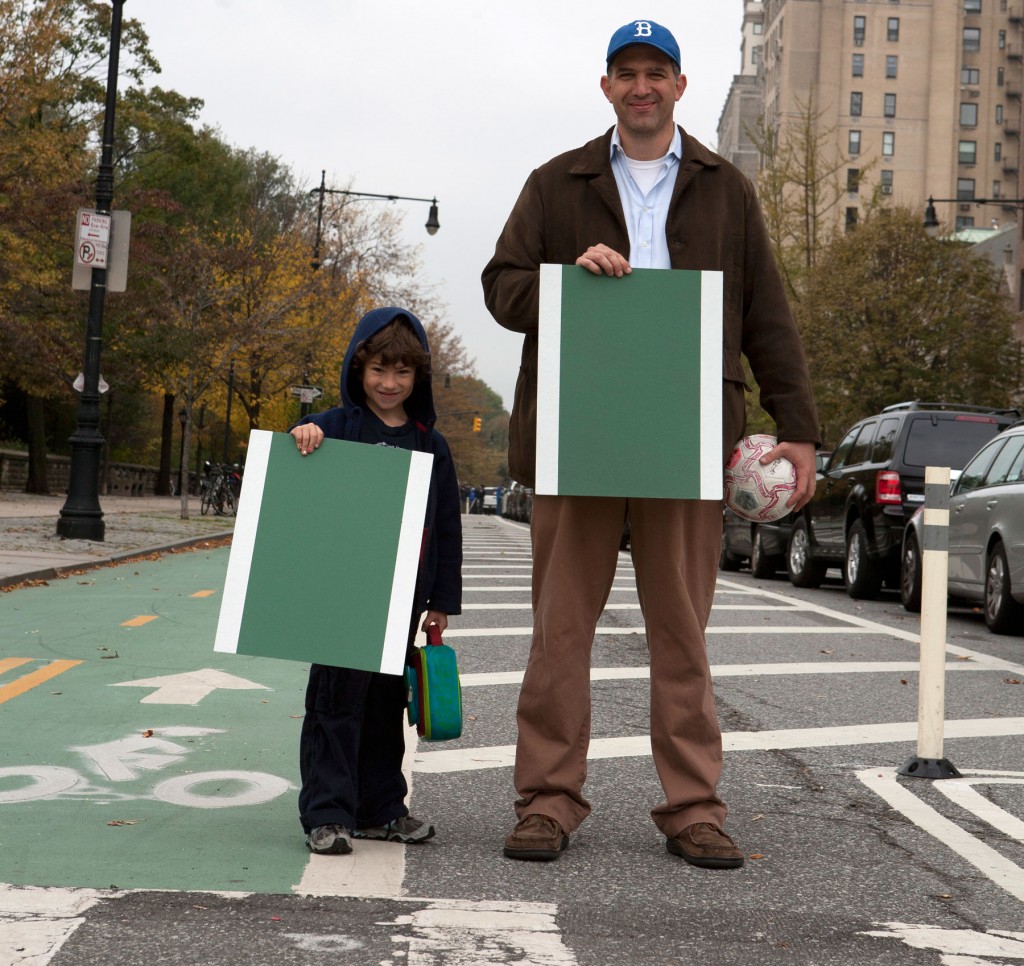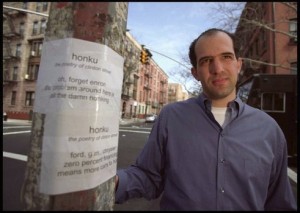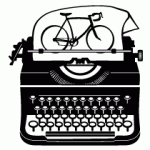
Aaron and his son in the controversial Prospect Park bike lane. Photo from naparstek.com.
In the past decade, New York City has seen a remarkable transformation from one of America’s worst bike cities to one of its most progressive. Like any political movement, the change was a confluence of many, many factors. And Aaron Naparstek seems to have his hands in a whole lot of them. From Honku–a neighborhood campaign centered on haiku about traffic–to work with Transportation Alternatives to founding StreetsBlog, he has played an important role in New York City’s evolution towards walkable, bikeable, livable streets.
In part one of this far-reaching interview, Aaron discusses his current work as a MIT Visiting Scholar and his recent Loeb Fellowship at Harvard, his roots in neighborhood activism and streets advocacy, and the foundation and growth of StreetsBlog, an influential advocacy journalism outlet in the livable streets movement. Part two continues next week with our discussion of pivotal moments in the history of New York City’s bike advocacy, the work necessary to continue its growth as a bike-friendly place, and the successes and shortcomings of modern American bike advocacy at large.
Let’s start with your current work. What are you doing as a visiting scholar at MIT?
The visiting scholar gig is at MIT’s department of Urban Studies and Planning. It’s a make-of-it what I will kind of position. Last Fall, I brought in a big grant from Southwest Airlines and produced a paper called “Places in the Making.” Southwest Airlines was interested in this question of what is place making and wanted help understanding that for their own corporate philanthropic purposes. I was able to bring that project to MIT and very specifically with some money attached. But really my main focus this year has been around the question of how best to use web-based software and social media tools for advocacy, community organizing, and campaigning. That’s something I’ve been thinking about and working on, generally focused on the realm on livable streets. How can you use these tools to build a movement that will change cities and do so in a way that’s inclusive and authentic to specific communities? And also a movement that just works and makes change happen in a way that doesn’t involve so much conflict and NIMBYism and foot dragging. The scale of the changes we need to make is so big.
And what about your recently finished Loeb Fellowship at Harvard? Were you working with the same questions or did that have a different focus?
Pretty much the same. That was a really great year. It was fun and interesting. I started to delve into these questions. I got to throw a lot of ideas out to different kinds of audiences and see what I personally had to bring in terms of experience and expertise. I also got to see what different kinds of audiences were interested in hearing from me. I spoke with advocacy groups in different cities. I spoke with academic audiences. Urban planners and government officials. I developed different presentations and talks. It was a good experience in getting better at presenting and learning how to speak to different groups.
You’re there with eight other fellows. It was also just a really nice year of making new friends. I was in a really unique group situation that you don’t really get to be a part of once you’re in your 40s. The last time you got something like this was in college. I was thrown in with this group and didn’t have all the pressures of deadlines and work. You can kind of just chill and get to know each other. The social aspect and benefitting from the experience and knowledge of the other fellows was a big part of that year.
You’re probably best known in the bike advocacy world as the founder of StreetsBlog. How did that project get started?
In 2005, I was working as a journalist and writing a column for a weekly newspaper called the New York Press. I was also doing advocacy work. It grew out of this intense hatred for all the horn honking taking place outside of my apartment in Brooklyn, which morphed into this project called Honku. The horn honking problem got me into this question of why our urban interface design is so lousy and who’s in charge of fixing it.
My career had mostly been spent as an interactive media producer. I was one of the first people doing web producing in New York, right out of journalism school. The web didn’t even really quite exist yet. It was 1993-94. We didn’t have Netscape yet. But so this was my world. I was designing interfaces for web traffic to flow through, for usability. People could click on the right button and go where they wanted to go. When I moved to Brooklyn and saw how the streets were designed and managed I kept looking at it as an interface design problem that was so blatantly broken. People on my corner have to honk at every light cycle. Someone gets hit by a car every two weeks. I put my journalism hat on and started delving into that question. I got really fascinated, obsessed frankly, with New York City streets.
I started to realize the problem in front of my house was systemic. The guys who are in charge of the public interface, the user interface in front of my apartment, they’re traffic engineers. They view this street as an onramp to the Brooklyn Bridge a mile down the street. They don’t see it as my neighborhood. I started asking myself why it was managed like a highway onramp instead of a neighborhood and how could you change that.
I’d also, coincidentally or not, started to become a bike commuter. Being a bike commuter in New York changed my view on the city and the public realm and streets. At that time–now we’re talking 1997-98–it was kind of a secret. You were in a secret society of people who’d figured out biking was this incredibly fast, convenient, fun, inexpensive way to get around the city. You’d go to parties and you’d say, hey man have you ever tried to bike into Manhattan? And they’d say, “are you crazy? there’s no way.” But I’d tell them it was incredible. You get there so fast. It was really predictable and you could get there on time and you weren’t stuck in the subway. It was a discovery of the bike. It changed my mental map of the city. I realized certain neighborhoods were really close together, which I never used to go to because they didn’t have a subway.
Then there was a third thing, I guess. My girlfriend, now my wife, Joanne, she was doing a professional training in Germany, near this town called Freiburg. I went to see her there. Freiburg happens to be this world renowned, almost car-free town. You fly into Frankfurt. You get on an intercity train and even though everything’s in German, the interface is designed so beautifully that an English speaker can figure out what to do. It’s so thoughtfully designed for human beings. I remember laughing at a sign that said “your train will be 20 seconds late.” Would a train in New York ever tell you if it was 20 seconds late? No. Maybe 20 minutes. The train drops you off in another town where you can get on a light rail. The light rail drops you off and you can get on a Deutsche Bahn Call A Bike to get to your final destination. It was the first public bike share I’d ever seen. The whole experience of Germany was amazing. I remember coming back to New York after that. I had the horn honking outside my apartment. I was so depressed. I felt like I was in a third-world country when it came to transportation.
I got really into the idea of how can we start to change this stuff. I started writing a weekly column for the New York Press called the Department of Traffic. That’s what the Department of Transportation used to be called. I felt like it was a more honest name. The Department of Defense used to be the Department of War. Isn’t that just a more honest name for what they did? “When you need a war, we’re your guys.” If you want more traffic in your neighborhood, call the Department of Traffic. For the last 60 years we’ve been retrofitting and redesigning New York City to fit more and more cars.
Every time I went to a meeting in the late 90s, the DOT guys would explain why you couldn’t have a bike lane. Why you couldn’t fix something for pedestrians. Why it would be so difficult to do something for bus riders. But if it came to adding another turn lane or traffic signal or widening something for cars, they had all kinds of ways to do that. I got really fixated on that. At the same time, I was starting to do advocacy work for Transportation Alternatives. That was right at the time that Paul Steely White was starting to take over at TA. He had all this international experience. He brought in outsiders like Jan Gehl and Enrique Penalosa, people from other countries that had managed to make the transition towards livable streets in other big cities. I realized while writing the weekly column that there was enough stuff starting to happen in New York in 2005 that this could easily be a blog. I could write about this stuff each day without a problem. I could find a bunch of headlines. I could find a photo of a FedEx truck blocking a bike lane. I could do one original piece of journalism. I could do that five days a week and that would be a pretty good blog.
At the same time there was this guy Mark Gorton. He was starting to fund all of this advocacy under the umbrella of the New York City Streets Renaissance Campaign. Paul introduced me to Mark. Originally we were there to talk about doing a book. But Mark and I both agreed that a book really wouldn’t change anything. We both wanted to reform New York City Department of Transportation. We thought it was utterly broken and that if people knew how the NYC DOT really thought and operated, they would see it was a scandal.
I went back to the drawing board for a few days then came back to Mark with my pitch for a blog. I said a blog would be a better way to move this set of issues higher up on the civic agenda and asked him to fund it. I had this whole 20 minute pitch ready. But I made it two minutes into the pitch and Mark was like “Good. I’m in. How much do you need?” It was the easiest fundraising pitch ever. And that was the birth of Streetsblog. I came to Mark with the idea and he was willing to essentially pay me what I needed to live to work on it full time. He had this organization Open Plans all set up so he was able to make me an employee and give me health insurance and there were a couple tech guys there. From there it was just “lets make this blog.”

Photo from bikinginheels-cycler.blogspot.com
The roots of StreetsBlog are clearly tied to your own advocacy. Tell me more about Honku.
Everything really started with Honku. It’s a ridiculous story. I got sick of the honking. I had an egg throwing incident with a guy one day. I threw eggs at his car. He flipped out completely. He got out of his car and said I’m coming back tonight, I’m going to kill you, I know where you live. And I was like right, that is a big flaw in my plan.
I started doing these haiku poems about honking. I would post them on lampposts. It became this neighborhood movement. Other people started doing honkus. Dozens of them were popping up on lampposts around the neighborhood. I realized I wasn’t the only person with this problem and started wondering how we could actually solve it. I created Honku.org letterhead and I wrote a letter to my newly elected city councilman, Bill de Blasio (now the Mayor of New York City). I explained we were having this problem on our street and we were calling ourselves Honku.org.
Bill, being a brand new city council member, was eager to do constituent services. I went to a local community police precinct meeting. I was going to talk to the cops about all the honking and why they weren’t enforcing the no honking signs with a large dollar penalty. But before I could even raise my hand, I noticed Bill was sitting there with a stack of papers on his lap. On the top of his stack of papers is my Honku.org letter. I decided to just see what happened. When he spoke he did a great job representing our problem on Clinton street to the commanding officer. The commanding officer was very respectful to the new city council member. He promised to get some resources out there and blitz for a few weeks. If that didn’t work he said they’d try something else. The cops deployed resources and the next week it was like crickets chirping. There was no honking because there were cops out there handing out tickets to drivers. It was this “wow” moment. It was the first time I’d ever tried to use representative democracy or advocacy for anything and it totally worked. Granted it was only a small honking problem, but it got me excited and optimistic. If you’re even just a little organized and articulate to advocate for yourself with a group of people, you can kind of change things.
Honku connected me to other livable streets groups and people like Paul White and the Transportation Alternatives folks. The TA guys liked me and asked me to work on the car-free Prospect Park campaign with them. They were trying to make it so that cars couldn’t go into Prospect Park anymore. It wasn’t my personal issue, but that just seemed like a no brainer to me. There are 15,000 miles of streets in New York City. Why do cars need two miles in Prospect Park also? There aren’t that many parks for 2.5 million people in Brooklyn. I began organizing and running the car-free park campaign. It was the same thing. We came up with a strategy. We were going to collect 10,000 signatures, force the city council members all around the park to show up at a town hall meeting. We were pushing for a summer long car-free trial. It was summer of 2003. And again, Bill de Blasio was the guy. I dropped a stack of signatures on his desk and he showed up at our town hall meeting. He brokered a deal for us. We didn’t get our three month trial period. But we did get all non-rush hour times to be car free in Prospect Park. It was the start of this continuous drip of incremental gains. That was another big lesson for me. You don’t necessarily get what you want. But there’s so many different ways to slice the pizza. Like maybe a certain road within the park can be car free at certain times. You can divide it up by time. You can divide it up by space. I really liked the creativity of it. There’s a lot of ways to solve this problem and make a win for yourself and for your cause.
How long were you with StreetsBlog. Were you part of its growth to other cities over the years?
Technically I’m still with SteetsBlog. I’m on the board. I was the editor for about five years. I did most of the expansion. Clarence Eckerson, Jr. was already doing videos for the Streets Renaissance Campaign. Clarence and I were buddies. We’d done a lot of advocacy stuff together. The first time I wanted to post one of his videos on StreetsBlog I was like “what are we going to call these?” We landed on StreetFilms. The thing was born of needing a name. It was like “here’s one of Clarence Eckerson’s new StreetFilms.” Then the StreetFilms became so incredibly popular on their own that we separated it out onto its own website.
Next I started up Los Angeles. That was just a city that Mark was very fascinated with. It happened that we had a local guy Damien Newton from New York who was living out there. Damien was very interested in getting a StreetsBlog up and running in LA so we did that.
I raised a bunch of money in 2008 or 2009 to launch San Francisco. I went to a conference and I was literally surrounded by advocates who were like we’re not letting you go til you figure out a plan for StreetsBlog San Francisco. We need it and want it here. They were in the middle of a horrible injunction that prevented them from getting any new bike stuff for four years. They were just dying.
Then the federal transportation stuff was getting started. There was supposed to be a big reauthorization of the transportation bill in 2009. I raised a bunch of money from some foundations to start a national StreetsBlog. We called it StreetsBlog Capitol Hill for a long time. Now it’s StreetsBlog USA. That also coincided with the start of the StreetsBlog Network.
Ben Fried was my deputy, starting in 2008. I handed it off to him and he’s done amazing things with it as Editor in Chief.
Click here to read part two of our conversation.
Like what you read on The Bicycle Story? Support the work with a donation or by buying a shirt.



Pingback: Aaron Naparstek: the Evolution of an Advocate from Honku to StreetsBlog and Beyond (Part 2) | The Bicycle Story